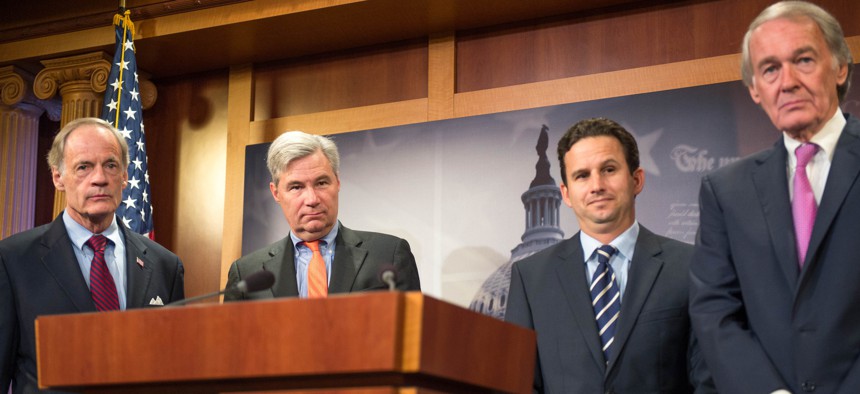The U.S. Senate Is Still One of the World's Whitest Workplaces
The membership of the upper chamber of Congress is famously unrepresentative of the American people—and so is its senior staff, a new study finds.
The U.S. Senate is famously known as the world’s most deliberative body, but it has never been its most representative. And that remains true not only of the 100 people elected to serve, but of the hundreds more hired as their top advisers.
Just over 7 percent of congressional aides who hold senior staff positions in the Senate are people of color, according to a new study set to be released Tuesday by the Joint Center for Political and Economic Studies. That amounts to just about 24 of the 336 people who hold top job titles, and it is a far lower percentage than the country as a whole, where people of color—defined as African Americans, Hispanic Americans, Asian Americans, and Native Americans—comprise about one-third of the population. The lack of diversity is particularly glaring among African Americans (0.9 percent of top staff positions) and in the offices of senators hailing from states with large black and Hispanic populations. And it suggests that little has changed in the decade since the online magazine Diversity Inc. called the Senate the nation’s worst employer for diversity.
In one way, the finding is not surprising. While the 114th Congress as a whole is the most diverse in history (admittedly a low bar), the Senate itself is notoriously unrepresentative as an elected body. There are just two African American senators and three Hispanics to go along with 20 women out of 100 senators. Yet the report’s author, James Jones of Columbia University, said he was still shocked to find the staff numbers to be so low, particularly in the offices of Democratic senators. “I didn’t expect it to be this bad,” he told me. The social demographics of senators naturally influences the social demographics of the people they hire as their senior advisers, Jones said. But, he added, “I don’t think diversity in the Senate—especially racial diversity—should be dependent on the racial backgrounds of senators. All senators come from states with racially diverse demographics, and so I think they have a responsibility to have staffs that look like the states that they represent.”
The Senate’s static diversity also bucks a trend in the federal government under President Obama, who has appointed a record percentage of minorities and women to posts requiring confirmation. The Senate, therefore, is approving a lot of minorities; it just isn’t hiring them. Jones told me that his research indicated that staff diversity in the top rungs of the Senate hadn’t changed much since the 1980s, despite periodic efforts to highlight and remedy the problem. In the mid-2000s, then-Senate Majority Leader Harry Reid created a diversity initiative to encourage minority hiring by Democratic offices. But Jones said the impact of that effort had been mixed: It helped staffers of color get their foot in the door with entry-level positions, but it didn’t make much difference in senior-level jobs. “Senior positions are more competitive, they’re more political, and the opportunities to fill these vacancies are more rare,” Jones said.
The study limited its focus to the top positions in personal and committee Senate offices based in Washington, noting that some senators had hired minority staffers in their home states and that there were some senior-level staffers of color in the separate party leadership offices. The House has a considerably more diverse staff at all levels, reflecting a more diverse elected membership. Around 70 of the chamber’s 435 lawmakers are members of either the Congressional Black Caucus or the Congressional Hispanic Caucus.
The Senate does not keep demographic data on its workforce, and so Jones had to rely on public records and interviews to conduct his study. One of the recommendations in the report is that the Senate begin to track and analyze data about its staff—something Congress requires of most federal agencies, but not of itself. The report also urged the Senate to adopt a version of the NFL’s “Rooney rule,” in which teams are required to interview at least one minority candidate for each top-level vacancy, even if they ultimately don’t hire them. One reason for taking the NFL’s lead is that the Senate is actually quite similar in structure: a weak central administration and dozens of independently-run teams, or offices. “While a Rooney rule alone is insufficient because many Senate offices will continue to hire within their personal staffs, the Rooney rule gives candidates of color experience interviewing and focusing on qualities to be a key Senate staffer,” Jones wrote. “Use of the Rooney rule may also increase the number of mid-level staffers of color, and thus the pool of candidates for top staff positions.”
Will that happen anytime soon? That seems unlikely. Spokesmen for Reid and Senate Majority Leader Mitch McConnell wouldn’t comment on the study, and neither party has made staff diversity a priority since Reid launched the Democratic effort nearly a decade ago. So the Senate remains an island in a federal bureaucracy that has diversified its ranks over the last several years—a place where the whiteness of its senior staff may be representative of the elected officials who hired them, but not of the changing electorate they serve.







